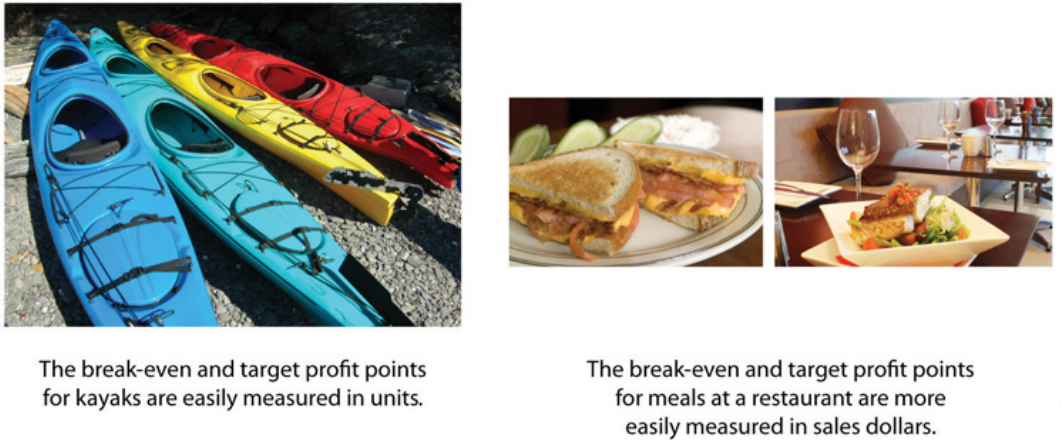23 4.3 Cost-Volume-Profit Analysis for Multiple-Product and Service Companies
-
Last updated
- Dec 28, 2020
Learning Objectives
- Perform cost-volume-profit analysis for multiple-product and service companies.
Question: Although the previous section illustrated cost-volume-profit (CVP) analysis for companies with a single product easily measured in units, most companies have more than one product or perhaps offer services not easily measured in units. Suppose you are the manager of a company called Kayaks-For-Fun that produces two kayak models, River and Sea. What information is needed to calculate the break-even point for this company?
-
- Finding the Break-Even Point and Target Profit in Units for Multiple-Product Companies
Question: Given the information provided for Kayaks-For-Fun, how will the company calculate the break-even point?
-
-
Break-Even Point in Unit and Weighted Average Contribution Margin per Unit
Question: Because most companies sell multiple products that have different selling prices and different variable costs, the break-even or target profit point depends on the sales mix. What is the sales mix, and how is it used to calculate the break-even point?
Target Profit in Units
Question: We now know how to calculate the break-even point in units for a company with multiple products. How do we extend this process to find the target profit in units for a company with multiple products?
Review problem 4.2
International Printer Machines (IPM) builds three computer printer models: Inkjet, Laser, and Color Laser. Information for these three products is as follows:
| Inkjet | Laser | Color Laser | Total | |
|---|---|---|---|---|
| Selling price per unit | $250 | $400 | $1,600 | |
|
Variable cost
per unit |
$100 | $150` | $800 | |
| Expected unit sales (annual) | 12,000 | 6,000 | 2,000 | 20,000 |
|
Sales mix
|
60 percent | 30 percent | 10 percent | 100 percent |
Total annual fixed costs are $5,000,000. Assume the sales mix remains the same at all levels of sales
-
- How many printers in total must be sold to break even?
- How many units of each printer must be sold to break even?
Finding the Break-Even Point and Target Profit in Sales Dollars for Multiple-Product and Service Companies
A restaurant like Applebee’s, which serves chicken, steak, seafood, appetizers, and beverages, would find it difficult to measure a “unit” of product. Such companies need a different approach to finding the break-even point. Figure 6.4 illustrates this point by contrasting a company that has similar products easily measured in units (kayaks) with a company that has unique products (meals at a restaurant) not easily measured in units.

Direct Materials Break-Even Points in Sales Dollars and Weighted Average Contribution Margin Ratio
Question: For companies that have unique products not easily measured in units, how do we find the break-even point?
- Question: We have the contribution margin ratio for each department, but we need it for the company as a whole. How do we find the contribution margin ratio for all of the departments in the company combined?
Target Points in Sales Dollars
Question: How do we find the target profit in sales dollars for companies with products not easily measured in units?
-
Important Assumptions
Question: Several assumptions are required to perform break-even and target profit calculations for companies with multiple products or services. What are these important assumptions?
Margin of Safety
Question: Managers often like to know how close expected sales are to the break-even point. As defined earlier, the excess of projected sales over the break-even point is called the margin of safety. How is the margin of safety calculated for multiple-product and service organizations?
Key Takeaway
- The key formula used to calculate the break-even or target profit point in units for a company with multiple products is as follows. Simply set the target profit to $0 for break-even calculations, or to the appropriate profit dollar amount for target profit calculations.
2. The formula used to find the break-even point or target profit in sales dollars for companies with multiple products or service is as follows. Simply set the “Target Profit” to $0 for break-even calculations, or to the appropriate profit dollar amount for target profit calculations:
Review problem 4.3
Ott Landscape Incorporated provides landscape maintenance services for three types of clients: commercial, residential, and sports fields. Financial projections for this coming year for the three segments are as follows:

Assume the sales mix remains the same at all levels of sales.
- How much must Ott Landscape have in total sales dollars to break even?
- How much must Ott Landscape have in total sales dollars to earn an annual profit of $1,500,000?
- What is the margin of safety, assuming projected sales are $5,000,000 as shown previously?
-
Definitions
- The proportion of one product’s sales to total sales.
- Calculated by multiplying each product’s unit contribution margin by the product’s proportion of total sales.
- The total contribution margin divided by total sales.


